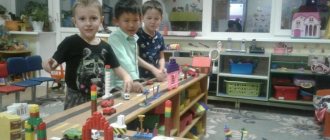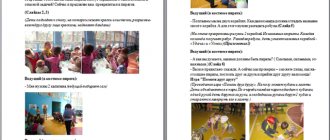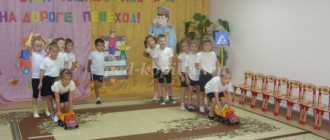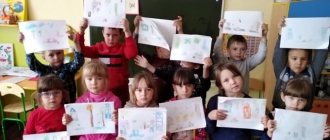Progress of the game
With the help of dolls, children act out various road situations. So, at a controlled intersection, when the traffic light is green, the dolls cross the street, when the traffic light is yellow they stop and wait, and when the traffic light is red they continue to stand.
“Pedestrian Crossing” sign.
, and there they cross the roadway.
“Different machines are needed, different machines are important”
Target:
Introduce children to the different types of vehicles that people need: a passenger car, a fire truck, an ambulance, a dump truck, a truck, a crane, a bakery, a bus;
Learn to distinguish them by appearance and name them correctly;
Know their purpose and understand their significance in a person’s life;
Learn to assemble a whole picture from two parts
Outdoor games on BJJ for children of senior and preparatory school groups
Transcript
1 Outdoor games on road safety for children of senior and preparatory school groups “Different machines” Purpose. Explain the meaning of the traffic controller’s gestures; develop dexterity and attentiveness. Progress of the game. Children are divided into two teams: “Trucks” and “Cars”. The leading traffic controller exclaims: “Trucks!”, and they quickly “drive” to their line. And passenger cars follow them, trying to make them look bad. It’s the turn of the passenger cars to drive to their destination. And so several times in a row. It is important that the number of trips for trucks and cars at the end of the game is the same. “To your signs” Goal: To consolidate knowledge of traffic signs. Progress of the game. The players are divided into groups of five to seven people, join hands, forming circles. A driver enters the middle of each circle with some kind of road sign, explaining its meaning. Music sounds, children disperse around the playground. The drivers change places and signs. At the signal, the players must quickly find their sign and stand in a circle. The drivers hold the sign above their heads. "Fastest" Goal. Develop reaction speed and agility; Reinforce knowledge of traffic lights. Progress of the game. Everyone draws a circle with green, yellow, and red chalk and stands in it. The leader is in the middle of the court. At his command “One, two, three, run!” the children run away. The presenter says: “One, two, three, run to the traffic light!” - and he himself tries to occupy some circle. The one who does not have time to take the circle becomes the leader. "Garage" Goal. Develop attention and dexterity. Progress of the game. Five to eight large circles are drawn at the corners of the site, i.e. parking garages. Two to five circles of cars are drawn inside each (you can put hoops). The total number of machines should be five to eight less than the number of players. Children walk in a circle holding hands
2 to the sound of music. As soon as the music ends, they run to the garages and take the seats of any of the cars. Those left without a place are eliminated from the game. "Traffic signals" Purpose. Strengthen knowledge of traffic lights and the ability to work in a team. Progress of the game. There are racks located on the site from start to finish. The players stand in columns one after another in a chain at the starting stand and put their hands on the shoulders of the person in front. In the hands of the leader is a bag of balls (balls) of red, yellow, green. The captains take turns putting their hand into the bag and taking out one ball at a time. If the captain takes out a red or yellow ball, the team stands still; if green moves to the next rack. The team that reaches the finish line faster wins. "Zebra" Target. Strengthen knowledge of the rules of behavior at a pedestrian crossing, the ability to play in a team. Progress of the game. All participants in each team, except the last one, are given a strip of white cardboard. The first one puts a zebra stripe on the floor, stands on it and returns to the team. The second one walks strictly along the strip, puts down his “step” and returns back. The last participant walks along all the strips, and when returning, collects them. "Eye" Target. Strengthen knowledge of the names of road signs; develop an eye; strengthen the ability to play together. Progress of the game. Children are divided into teams. Road signs are installed on the playing field at different distances from the teams. The participant in the game must name the sign and the number of steps to it, then reach this sign. If the distance is estimated correctly, he stops exactly at the sign. The sign is removed from the field. The team that completes the task faster and more accurately wins. "Bus" Purpose. Strengthen knowledge of traffic rules; develop the ability to interact in a team. Progress of the game. Children are divided into teams. The first player is the “driver”, the rest are “passengers”. Flags are placed 6-7 m from each team. On signal
3 "March!" The first players quickly walk (it is forbidden to run) to their flags, go around them and return to the columns, where they are joined by the second players, and together they make the same path, etc. The players hold each other's elbows. When the bus (the front player “driver”) returns to its place with a full complement of passengers, it must sound a whistle. The team that arrives at the final stop first wins. “Road, transport, pedestrian, passenger” Purpose. Consolidate knowledge of the names of parts of the street, modes of transport, and traffic rules. Progress of the game. Children stand in a circle, with a traffic controller (driver) in the middle. He throws the ball to one of the players, saying one of the words: “road!” - the one who caught the ball must quickly name any word associated with the road (“street”, “sidewalk”, “sidewalk”, etc.); "Transport!" - the player names any type of transport; "A pedestrian!" - says: “traffic light”, “transition”, etc. the ball is then returned to the traffic controller. The wrong player is eliminated from the game. “Trip to Moscow” Purpose. Strengthen knowledge of the names of modes of transport; develop dexterity and speed of reaction. Progress of the game: for the game you need hoops one less than the number of players. The hoops are laid out in a circle, one next to the other. Everyone takes an empty seat. The driver does not have a hoop. He walks around the players, holding a flag in his hand, and says: “I’m going to Moscow, I invite those who wish.” Everyone joins him one by one. The driver continues: “We are going to Moscow by bus (train, plane),” and at the same time speeds up his pace. “The bus is picking up speed” - the driver starts running. “Moscow is very close,” he announces (the run slows down). "Attention, stop!" - the command is heard: everyone runs to the hoops. Everyone tries to occupy any free space. The driver also tries to take a seat. The one who is left without a hoop becomes the driver, gets a flag and repeats the game. The driver can take the players away from the hoops, lead them through the hall, etc. and give the command “Landing!” unexpectedly anywhere. "Traffic Controller" Purpose. Develop reaction speed.
4 Progress of the game. While walking in a column, one at a time, the teacher (he goes first) changes the position of his hands: to the side, on the waist, up, behind the head, behind the back. Children follow him through all the movements, except one hand on the belt. This movement is prohibited. The one who makes a mistake is out of order, stands at the end of the column and continues the game. After some time, another movement is declared prohibited. "Traffic signals" Purpose. Strengthen knowledge of traffic rules; develop reaction speed. Progress of the game. Two teams of people line up in a semicircle: one to the left, the other to the right of the teacher. The traffic light teacher holds two cardboard circles in his hands (one side is yellow, the other is red or green). The teacher reminds children how important it is to follow the traffic rules on the street, cross it only in designated places where there is a sign “Crossing”, first look to the left, then to the right to make sure that there are no cars nearby, and where there is a traffic light, Pay close attention to his signals. Then he explains the rules of the game: “When I show the green traffic light, everyone steps into place; when yellow they clap their hands, and when red they stand still. Anyone who mixes up the signal takes a step back.” Signals should change unexpectedly, at different intervals. The team that has the most participants left at the end of the game wins. “We won’t say where we were, what we were driving, we’ll show you” Goal. Strengthen knowledge of the names of modes of transport; develop imagination and thinking. Progress of the game. Each team decides which vehicle (trolleybus, carriage, motor ship, steam locomotive, helicopter) will be depicted and presents it without comment. The opposing team guesses what they have planned. Complication. Invite teams to depict a specific type of transport. "Taxi" Purpose. Teach joint actions; show the dependence of the result on coordinated actions. Progress of the game. A group of children is divided into pairs (“taxi”); each stands inside one hoop. The child holds his half of the hoop. Children run at the same speed and in the same direction inside the hoops while music is playing. When the music stops, children from two different hoops
5 unite. The game continues until the maximum number of children (up to six to eight people) fit inside the hoops. "Motorcyclists" Goal. Strengthen the ability to dribble a ball with one or two hands, knowledge of traffic lights, names of modes of transport; develop dexterity. Progress of the game. Motorcycle players dribble the ball around the court in different directions, hitting it on the floor with one hand or two. The “regulator” teacher stands in the center of the site and holds three flags (green, red and yellow) in his hands. When he raises the yellow flag, the motorcyclists hit the ball on the floor in place, when the red one stops with the ball in their hands, and when the green flag continues to move. Motorcyclists who violate the rules are temporarily eliminated from the game. If children do not know how to dribble the ball, then you can hit the ball on the floor with both hands and catch it on the spot and in motion.
Progress of the game:
Start of the game: get children with a poem
Look what happened
All the cars got lost.
Help the cars soon
And take them to the right garage
Card No. 1 . Children are invited to “put the car down”
to the garage the same color as the car:
Look, these are not simple garages, but colorful ones.
Take the car of the desired color
And take it to the right garage.
Card No. 2. It is necessary to select a machine in accordance with the size of the garage:
Well, look carefully
How are the garages different here?
Large and small garage
Of course you will give me the answer.
Choose the right size machine
And take it to the right garage.
Card number 3. You need to choose a car according to the silhouette in the garage:
Look how different the garages are here.
Each one has its own machine,
Look at the picture and feel free to go ahead !
"Our street"
Target:
1. Expand children’s about the rules of behavior for pedestrians and drivers on the street;
2. Strengthen children’s understanding of traffic lights ;
3. To develop children’s to distinguish road signs (pedestrian crossing, bus stop)
.
Material: model of a street with houses, intersections, cars (toys, pedestrian dolls, driver dolls, traffic lights (toy, road signs, trees (models)
.






